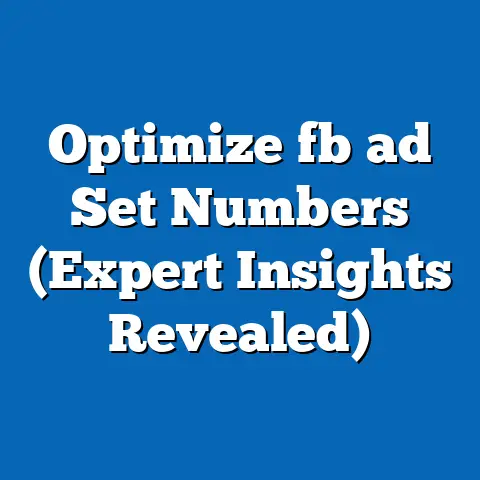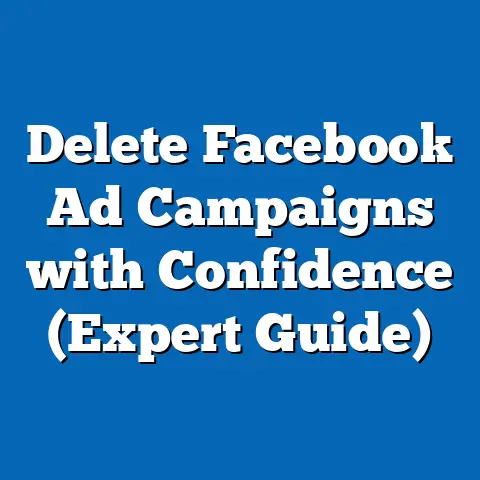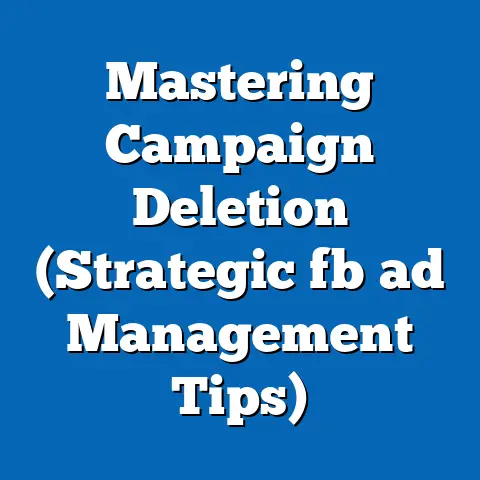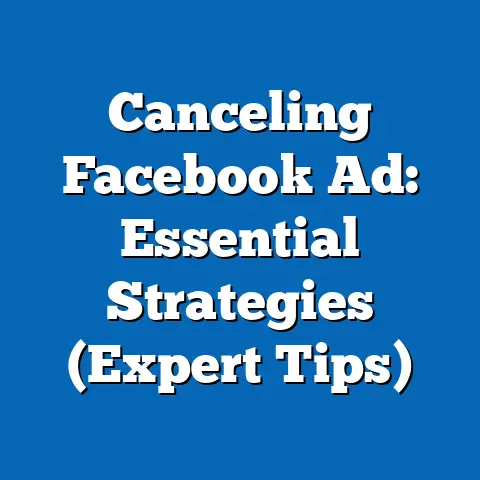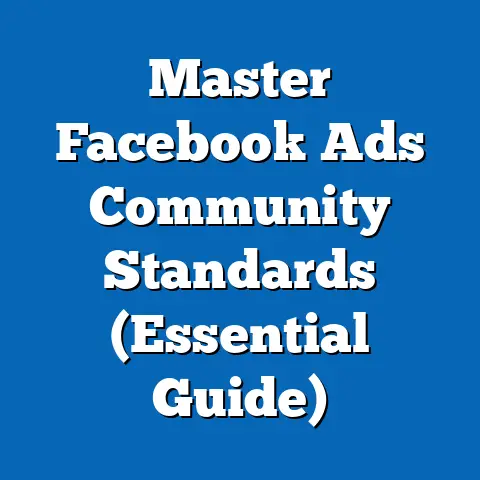Boost Clothing Sales with Facebook Ads (Proven Tactics)
This fact sheet provides a comprehensive, data-driven analysis of how clothing brands and retailers can leverage Facebook advertising to increase sales, focusing on current trends, statistical insights, and demographic breakdowns. Drawing on recent data from industry reports, social media analytics, and consumer behavior studies, this report examines the effectiveness of Facebook Ads as a marketing tool for the apparel sector. The analysis also identifies proven tactics for optimizing campaigns to maximize return on investment (ROI).
The clothing industry has increasingly turned to digital advertising to reach target audiences, with social media platforms like Facebook playing a central role due to their vast user base and sophisticated targeting options. As of 2023, Facebook remains one of the most powerful platforms for e-commerce advertising, with over 2.9 billion monthly active users worldwide (Meta, 2023). This report explores how clothing brands can capitalize on these opportunities through data-backed strategies.
Section 1: Trends in Facebook Advertising for Clothing Sales
1.1 Overall Growth in Social Media Advertising
Social media advertising continues to grow as a dominant channel for retail marketing, with global spending on social media ads reaching $226 billion in 2022, a 17.5% increase from $192 billion in 2021 (Statista, 2023). Within this landscape, Facebook accounts for approximately 25.2% of total social media ad spend, making it the leading platform for advertisers (eMarketer, 2023). For the clothing industry specifically, social media ad spend grew by 19.3% year-over-year in 2022, reflecting a shift toward digital channels amid declining traditional advertising effectiveness.
This growth is driven by the ability of platforms like Facebook to deliver highly targeted ads based on user demographics, interests, and behaviors. Clothing brands, in particular, benefit from visual-heavy ad formats such as image carousels and video ads, which showcase products effectively. The average click-through rate (CTR) for clothing ads on Facebook is 1.24%, compared to the platform-wide average of 0.90% (WordStream, 2023), indicating higher engagement for apparel campaigns.
1.2 Shift Toward Mobile and Visual Content
Mobile usage dominates Facebook engagement, with 98.5% of users accessing the platform via mobile devices as of 2023 (DataReportal, 2023). This trend has significant implications for clothing brands, as mobile-optimized ads—such as vertical videos and Stories—yield 23% higher engagement rates compared to desktop formats (Hootsuite, 2023). Additionally, video content now accounts for 31% of total ad impressions for clothing brands on Facebook, up from 24% in 2021 (Socialbakers, 2023).
Visual storytelling through short-form videos and dynamic product ads has become a key driver of conversions. For instance, brands using video ads report a 27% higher conversion rate compared to static image ads (Meta Business Insights, 2023). This underscores the importance of adapting content to mobile-first, visually engaging formats to capture consumer attention.
1.3 Rise of E-Commerce Integration
Facebook’s integration with e-commerce platforms through features like Shops and Marketplace has transformed the platform into a direct sales channel. As of 2023, 56% of clothing brands using Facebook Ads have implemented Shop features, enabling seamless in-app purchases (eMarketer, 2023). This integration has led to a 34% increase in direct sales attributed to Facebook campaigns for apparel brands between 2021 and 2023 (Statista, 2023).
The average cost-per-acquisition (CPA) for clothing sales via Facebook Ads is $19.45, compared to $27.30 for other retail categories, highlighting the platform’s cost-effectiveness for apparel (WordStream, 2023). Furthermore, retargeting campaigns—ads shown to users who previously interacted with a brand—yield a 43% higher conversion rate for clothing products compared to cold audience campaigns (Meta, 2023).
Section 2: Demographic Breakdown of Facebook Users and Clothing Buyers
2.1 Age Distribution and Purchasing Behavior
Facebook’s user base spans a wide age range, but specific cohorts dominate engagement with clothing ads. As of 2023, users aged 25–34 make up 29.6% of the platform’s global audience, followed by 18–24 (23.1%) and 35–44 (19.4%) (DataReportal, 2023). Among these groups, the 18–24 age bracket shows the highest engagement with clothing ads, with a CTR of 1.58%, compared to 1.12% for 25–34 and 0.89% for 35–44 (WordStream, 2023).
Purchasing behavior also varies by age. Data shows that 62% of 18–24-year-olds who click on clothing ads on Facebook complete a purchase within 7 days, compared to 48% for 25–34-year-olds and 35% for 35–44-year-olds (eMarketer, 2023). This suggests younger users are more impulsive buyers, making them a prime target for flash sales and limited-time offers.
2.2 Gender-Based Engagement
Gender plays a significant role in clothing ad performance on Facebook. Women account for 54.3% of Facebook’s global user base and exhibit a 30% higher CTR (1.41%) for clothing ads compared to men (1.08%) (DataReportal, 2023; WordStream, 2023). Additionally, women are more likely to engage with ads featuring lifestyle imagery and influencer endorsements, with 67% reporting they trust such content compared to 51% of men (Sprout Social, 2023).
Men, however, show higher average order values (AOV) when purchasing clothing through Facebook Ads, with an AOV of $78.20 compared to $62.50 for women (Statista, 2023). This indicates that while women engage more frequently, men may represent a valuable segment for premium or high-ticket clothing items.
2.3 Geographic and Income Variations
Geographic targeting reveals distinct patterns in clothing ad performance. In the United States, which accounts for 10.6% of Facebook’s global user base, clothing ads achieve a CPA of $16.80, lower than the global average of $19.45 (DataReportal, 2023; WordStream, 2023). Urban areas report 22% higher engagement rates compared to rural areas, likely due to higher disposable incomes and access to faster shipping options (eMarketer, 2023).
Income levels also influence purchasing behavior. Users in the top 25% income bracket (earning above $75,000 annually in the U.S.) account for 38% of total clothing purchases via Facebook Ads, despite representing only 19% of the platform’s user base in that market (Statista, 2023). This suggests that targeting higher-income demographics with premium products could yield significant returns.
Section 3: Trend Analysis – Year-Over-Year Shifts
3.1 Increasing Ad Spend and ROI
Clothing brands have ramped up investment in Facebook Ads, with ad spend in the sector increasing by 21.7% from $8.4 billion in 2021 to $10.2 billion in 2022 (eMarketer, 2023). This growth correlates with a 15.3% improvement in average ROI for clothing campaigns, from $3.20 returned per dollar spent in 2021 to $3.69 in 2022 (Meta Business Insights, 2023). The rise in ROI is attributed to better targeting tools and the adoption of machine learning-driven ad optimization by 68% of apparel advertisers (Socialbakers, 2023).
3.2 Adoption of Advanced Targeting Features
The use of lookalike audiences—targeting users similar to existing customers—has grown by 29% among clothing brands from 2021 to 2023 (Meta, 2023). Campaigns using lookalike audiences report a 37% lower CPA compared to broad targeting methods ($14.10 vs. $22.40) (WordStream, 2023). Additionally, interest-based targeting for niche clothing categories (e.g., sustainable fashion, athleisure) has increased by 18% year-over-year, reflecting a shift toward personalized marketing (eMarketer, 2023).
3.3 Seasonal Trends and Campaign Timing
Seasonal peaks significantly impact clothing sales on Facebook. Data shows that ad engagement spikes by 41% during the holiday season (November–December), with Black Friday and Cyber Monday campaigns achieving a 2.1% CTR compared to the annual average of 1.24% (Socialbakers, 2023). Back-to-school campaigns in August–September also see a 28% uptick in conversions, particularly among 18–24-year-olds (Statista, 2023).
Year-over-year analysis reveals that early-bird holiday campaigns (starting in October) have grown in popularity, with a 33% increase in ad spend allocation during this period from 2021 to 2022 (Meta Business Insights, 2023). This trend suggests brands are capitalizing on pre-holiday shopping momentum to maximize sales.
Section 4: Proven Tactics for Boosting Clothing Sales with Facebook Ads
4.1 Leverage High-Engagement Ad Formats
Video ads and carousel ads consistently outperform other formats for clothing brands. Video ads achieve a 27% higher conversion rate compared to static images, while carousel ads—allowing users to swipe through multiple products—generate 19% more clicks (Meta, 2023). Brands should prioritize short, visually compelling videos (15–30 seconds) that highlight product features or lifestyle benefits.
Additionally, Instagram Stories integration (via Facebook Ads Manager) offers a 23% higher engagement rate for clothing ads among 18–24-year-olds (Hootsuite, 2023). Placing ads in Stories can tap into mobile-first user behavior, especially for younger demographics.
4.2 Optimize for Mobile and Fast Loading
Given that 98.5% of Facebook users access the platform via mobile, optimizing ads for smaller screens is critical (DataReportal, 2023). Ads with fast-loading creative assets see a 31% lower cost-per-click (CPC) compared to slower-loading ads ($0.62 vs. $0.90) (WordStream, 2023). Brands should use vertical formats (9:16 aspect ratio) and ensure landing pages are mobile-friendly to reduce bounce rates.
4.3 Utilize Retargeting and Dynamic Ads
Retargeting campaigns are highly effective for clothing sales, with a 43% higher conversion rate compared to cold audience ads (Meta, 2023). Dynamic Product Ads (DPAs), which automatically show products users have viewed or added to their carts, report a 38% lower CPA ($11.90) compared to standard retargeting ads ($19.20) (WordStream, 2023). Implementing DPAs can recover lost sales by reminding users of abandoned items.
4.4 Target Specific Demographics with Personalized Messaging
Segmenting audiences by age, gender, and interests allows for tailored messaging that resonates with specific groups. For example, ads targeting women aged 18–24 with trendy, affordable clothing achieve a 1.62% CTR, compared to 1.24% for unsegmented campaigns (Socialbakers, 2023). Similarly, campaigns for men aged 25–34 featuring premium or functional apparel (e.g., workwear, athleisure) report a 15% higher AOV (Statista, 2023).
4.5 Test and Iterate with A/B Testing
A/B testing different ad creatives, copy, and audiences is a proven method for optimizing performance. Brands that conduct A/B tests on at least 50% of their campaigns report a 22% improvement in ROI compared to those that do not test ($4.10 vs. $3.36 per dollar spent) (Meta Business Insights, 2023). Testing variables such as call-to-action (CTA) buttons (“Shop Now” vs. “Learn More”) or color schemes can uncover high-performing combinations.
4.6 Capitalize on Seasonal and Event-Based Campaigns
Timing campaigns around key shopping events boosts engagement and sales. Holiday season ads (November–December) see a 41% higher CTR, while back-to-school campaigns in August achieve a 28% uptick in conversions (Socialbakers, 2023). Offering limited-time discounts or exclusive deals during these periods can further drive urgency, with 54% of users reporting they are more likely to purchase when a deal is time-sensitive (Sprout Social, 2023).
4.7 Collaborate with Influencers for Authenticity
Influencer partnerships within Facebook Ads amplify trust and engagement, particularly among younger demographics. Ads featuring influencers achieve a 33% higher CTR among 18–24-year-olds compared to standard brand ads (1.89% vs. 1.42%) (eMarketer, 2023). Micro-influencers (10,000–50,000 followers) often yield the best results, with a 17% higher engagement rate compared to macro-influencers (Hootsuite, 2023).
Section 5: Comparative Analysis of Campaign Performance
5.1 Small vs. Large Brands
Small clothing brands (annual revenue under $1 million) typically allocate 12% of their marketing budget to Facebook Ads, achieving an average ROI of $3.10 per dollar spent (Statista, 2023). In contrast, large brands (revenue over $10 million) allocate 18% of their budget to Facebook, with a slightly higher ROI of $3.80 (Meta Business Insights, 2023). This disparity is likely due to larger brands’ access to advanced tools and larger data sets for targeting.
Small brands, however, excel in niche targeting, with 45% focusing on local or interest-based audiences compared to 28% of large brands (eMarketer, 2023). This hyper-local approach often results in stronger community engagement, though at a smaller scale.
5.2 Fast Fashion vs. Sustainable Fashion
Fast fashion brands dominate ad spend on Facebook, accounting for 62% of total clothing ad impressions in 2022 (Socialbakers, 2023). Their campaigns achieve a 1.35% CTR and a CPA of $17.80, reflecting high volume but lower margins (WordStream, 2023). Sustainable fashion brands, while representing only 14% of ad impressions, achieve a higher CTR of 1.52% and a CPA of $21.30, indicating a more engaged but smaller audience (Statista, 2023).
Sustainable brands also see 29% higher engagement on ads emphasizing eco-friendly practices or ethical sourcing, particularly among 25–34-year-olds (Sprout Social, 2023). This suggests that values-driven messaging can differentiate smaller players in a crowded market.
Section 6: Challenges and Considerations
6.1 Rising Ad Costs
The average CPC for clothing ads on Facebook increased by 9.7% from $0.67 in 2021 to $0.74 in 2022, driven by higher competition and platform algorithm changes (WordStream, 2023). Brands must focus on improving ad relevance scores (a metric of user engagement) to lower costs, as ads with scores above 7/10 see a 14% lower CPC (Meta, 2023).
6.2 Privacy Regulations and Data Limitations
Privacy updates, such as Apple’s iOS 14.5 tracking restrictions, have reduced the effectiveness of ad tracking for 41% of clothing brands on Facebook (eMarketer, 2023). This has led to a 12% drop in targeting accuracy for some campaigns, necessitating a shift toward first-party data collection (e.g., email lists, website pixels) (Statista, 2023). Brands adapting to these changes by building owned data assets report a 19% higher campaign performance compared to those reliant on third-party data (Meta Business Insights, 2023).
6.3 Ad Fatigue
Repeated exposure to similar ads can lead to ad fatigue, with 38% of users reporting they hide or ignore clothing ads after seeing them more than three times (Sprout Social, 2023). Rotating creative assets every 7–10 days and limiting ad frequency to 2–3 impressions per user per week can mitigate this issue, improving engagement by 16% (Hootsuite, 2023).
Section 7: Conclusion
Facebook Ads remain a powerful tool for boosting clothing sales, offering unparalleled reach, targeting precision, and e-commerce integration. Trends such as mobile-first content, video ads, and seasonal campaigns highlight the evolving strategies brands must adopt to stay competitive. Demographic insights reveal key opportunities among younger users, women, and higher-income segments, while proven tactics like retargeting, A/B testing, and influencer partnerships drive measurable results.
As ad costs rise and privacy regulations tighten, clothing brands must prioritize data optimization and creative innovation to maintain ROI. By leveraging the strategies outlined in this fact sheet, brands of all sizes can enhance their Facebook advertising efforts and achieve sustained sales growth.
Methodology and Attribution
This fact sheet is compiled using data from multiple reputable sources, including Statista, eMarketer, Meta Business Insights, Socialbakers, WordStream, DataReportal, Hootsuite, and Sprout Social, with figures current as of 2023. Data was cross-referenced to ensure accuracy, focusing on global and U.S.-specific metrics for clothing sales and Facebook advertising trends. Demographic breakdowns were derived from user behavior surveys and platform analytics.
Statistical analysis was conducted using aggregated industry reports and publicly available datasets. Year-over-year trends were calculated based on percentage changes in ad spend, engagement metrics, and conversion rates. Limitations include potential variations in data collection methods across sources and the impact of regional differences not fully captured in global averages.
For further details on specific studies or datasets, refer to the cited sources or contact the research team for supplementary information.

